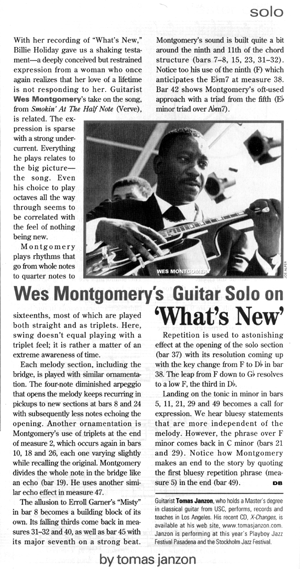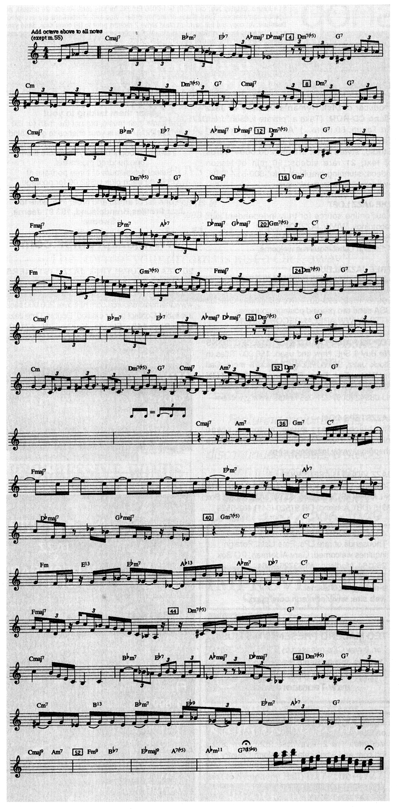|
|
About
Wes Montgomery's Guitar solo on "What's New", Tomas
wrote this article for Downbeat Magazine
in July 2001.
With
her recording of "What's New," Billie Holiday gave us a
shaking testament--a deeply conceived but restrained expression from a
woman who once again realizes that her love of a lifetime is not
responding to her. Guitarist West Montgomery's take on the song, from
Smokin' At The Half Note (Verve), is related. The expression is sparse
with a strong undercurrent. Everything he plays relates to the big
picture--the song. Even his choice to play octaves all the way through
seems to be correlated with the feel of nothing being new.
Montgomery plays rhythms that go from whole notes to quarter notes to
sixteenths, most of which are played both straight and as triplets.
Here, swing doesn't equal playing with a triplet feel; it is rather a
matter of an extreme awareness of time.
Each melody section, including the bridge, is played with similar
ornamentation. The four-note diminished arpeggio that opens the melody
keeps recurring in pickups to new sections at bars 8 and 24 with
subsequently less notes echoing the opening. Another ornamentation is
Montgomery's use of triplets at the end of measure 2, which occurs again
in bars 10, 18,and 26, each one varying slightly while recalling the
original. Montgomery divides the whole note in the bridge like an echo
(bar 19). He uses another similar echo effect in measure 47.
The allusion to Erroll Garner's "Misty" in bar 8 becomes a
building block of its own. Its falling thirds come back in measures
31-32 and 40, as well as bar 45 with its major seventh on a strong beat.
Montgomer'ys sound is built quite a bit around the ninth and 11th of the
chord structure (bars 7-8,15, 23, 31-32). Notice too his use of the
ninth (F) which anticipates the Ebm7
at measure 39. Bar 42 shows Montgomery's oft-used approach with a triad
from the fifth (Eb
minor triad over Abm7).
Repetition is used to astonishing effect at the opening of the solo
section (bar 37) with its resolution coming up with the key change from
F to Db
in bar 38. The leap from F down to Gb
resolves to a low F, the third in Db.
Landing on the tonic in minor in bars 5, 11, 21, 29 and 49 becomes a
call for expression. We hear bluesy statements that are more independent
of the melody. However, the phrase over F minor comes back in C minor
(bars 21 and 29). Notice how Montgomery makes an end to the story by
quoting the first bluesy repetition phrase (measure 5) in the end (bar
49).
Guitarist Tomas Janzon, who holds a Master's degree in classical guitar
from USC, performs, records and teaches in Los Angeles.
|
 |

